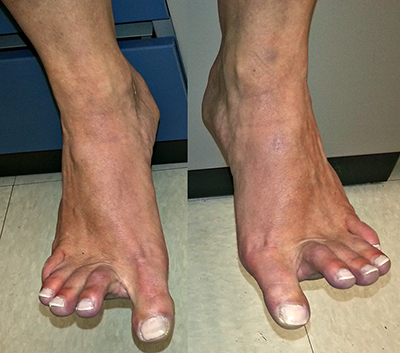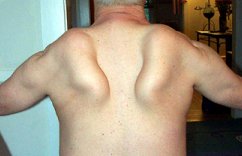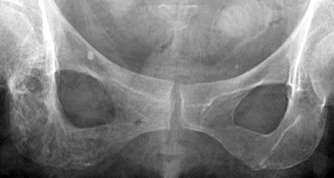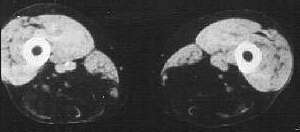DISTAL WEAKNESS
Differential Dx
General
Features
Pathology
Myopathies
ACTN2: 1q43
Congenital myopathies
ACTA1
Centronuclear 2: DNM2; 19p13
RYR1
Cystinosis + Renal: CTNS; 17p13
Cytoplasmic body
Distal dystrophy: PLIN4; 19p13
Emery-Dreifuss
FSH dystrophy
Glycogenoses
Acid maltase
Debranching Enzyme
Phosphorylase b Kinase
Gowers-Laing (MPD1): MYH7; 14q11
Hereditary IBM
Dominant
Recessive
Respiratory failure
LGMD variants
1A: Myotilin; 5q31
1C: Caveolin-3; 3p25
1D: DNAJB6; 7q36
2B: Dysferlin; 2p13
2G: Telethonin; 17q12
2L: ANO5; 11p14
Mitochondrial: POLG1; 15q26
Miyoshi (MMD)
MMD1: Dysferlin; 2p13
MMD2: ? 10p
MMD3: ANO5; 11p14
MPD
1 (Gowers-Laing): MYH7; 14q11
2 (Vocal cord): MATR3; 5q31
3: HNRNPA1; 12q13
4 (Williams): FLNC; 7q32
5 (Adolescent): ADSSL1; 14q32
6: ACTN2
7: SMPX; Xp22
Myasthenia: Agrin; 1p36
Myofibrillar
αB-crystallin: 11q22
BAG3
CCDC78: 16p13
Desmin: 2q35
Filamin C (MPD4): 7q32
Myotilin
Scapuloperoneal: 12q13
ZASP (LDB3): 10q23
Myofibrillary (Cytoplasmic body)
Myopathy + Paget's disease of bone
with Dementia: VCP/p97; 9p13
Type 2: HNRNPA2B1; 7p15
Myopathy + PEO: MYH2; 17p13
Myotonic Dystrophy 1: DMPK; 19q13
Nebulin: 2q23
Nemaline (Rod) myopathies
Neutral lipid storage: PNPLA2; 11p15
Nonaka-HIBMR: GNE; 9p13
Oculopharyngodistal
Ring fiber myopathy
Scapuloperoneal syndromes
SQSTM1: 5q35; Dominant
TDP43; 1p36
Titin; 2q31
Finnish: Dominant
Serbian: Recessive
Welander: TIA1; 2p13
Other
Myopathy or Motor Neuropathy
Distal weakness: KLHL9; 9p22
Distal weakness: HSPB8; 12q24
Distal weakness: SPTAN1; 9q34
Distal, Hoarse, Deaf: MYH14; 19q13
Distal atrophy: DNAJB5; 9p13
Neuropathies
Uncertain
NSUN2
Acquired (Sporadic) disorders
Myasthenia gravis
Myopathy + Neuropathy
Hyperthyroid
IIM + VAMP (IBM-like) syndromes
Inclusion Body Myositis
|
|
Type |
Inheritance
Pattern |
Gene &
Locus |
Early
Weakness |
CK |
Muscle |
|
Welander
|
Dominant
|
TIA1
2p13
|
> 40 years
Hands: Extensor
|
Normal, or
Slight ↑
|
Myopathic
± Vacuoles
|
Finnish
(Tibial; Udd)
|
Dominant
|
Titin
2q31
|
40 to 50 years
Legs: Anterior
|
Normal, or
Slight ↑
|
Myopathic
Vacuoles
|
HMERF
|
Dominant
|
Titin
2q31
|
12 to 75 years
Distal anterior legs
Respiratory
|
Normal or
Slight
↑
|
Myopathic
Eosin inclusions
Cytoplasmic body
Vacuoles
|
Gowers-Laing
(MPD1)
|
Dominant
|
MYH7
14q11
|
1.5 to 25 years
Dorsiflex: Ankle; Toe
|
↑
up to 3x
|
Myopathic: Mild
Vacuoles: Few
|
Distal dystrophy +
Rimmed vacuoles
|
Dominant
|
DNAJB6
7q36
|
10 to 50 years
Legs: Distal
|
Normal, or
Slight ↑
|
Myopathic
Vacuoles
|
|
HIBM1
|
Dominant
|
Desmin
2q35
|
25 to 40 years
Legs: Distal;
Quadriceps
|
Normal, or
Slight ↑
|
Myopathic
Vacuoles
|
|
Oculopharyngodistal
|
Dominant
|
Autosomal
|
40 years
Extraocular
|
3x ↑
|
Myopathic
Vacuoles
|
Vocal cord &
Pharyngeal
(MPD2)
|
Dominant
|
Matrin 3
5q31
|
35 to 57 years
Legs, Hands
or Vocal cord
|
Normal to
↑ 8x
|
Myopathic
Vacuoles
|
Myopathy +
Paget's & Dementia
|
Dominant
|
VCP
9p13
|
20 to 40 years
Legs
Proximal & Distal
|
Normal or
Slight
↑
|
Myopathic
Vacuoles
|
|
Myopathy + Paget's
|
Dominant
|
HNRNPA2B1
7p15
|
35 to 42 years
Legs: Distal
Scapular
|
Normal
or High
|
Myopathic
|
|
MPD3
|
Dominant
|
HNRNPA1
12q13
|
32 to 45 years
Distal
Legs & Hands
|
Normal or
Slight
↑
|
Myopathic
Vacuoles
|
|
Cytoplasmic body
|
Dominant
|
Autosomal
|
40 to 50 years
Hands
|
Normal or
Slight
↑
|
Myofibrillary
inclusions
|
Myopathy with
Anterior leg sparing
(MPD4)
|
Dominant
|
Filamin C
7q32
|
0 to 30 years
Distal
Legs & Hands
|
Normal or
Slight
↑
|
Varied
fiber size
No vacuoles
|
Nonaka-HIBMR
(HIBM2)
|
Recessive,
or Sporadic
|
GNE
9p13
|
20 to 40 years
Legs: Anterior
|
↑ up to 5x
|
Myopathic
Vacuoles
|
Miyoshi ±
LGMD 2B
|
Recessive,
or Sporadic
|
Dysferlin
2p13
|
20 to 50 years
Legs: Posterior
|
10x to
150x ↑
|
Myopathic
No vacuoles
|
|
LGMD 2G
|
Recessive
|
Telethonin
17q12
|
12 years
Legs: Proximal
& Anterior distal
|
3x to 17x ↑
|
Myopathic
Vacuoles
|
Miyoshi-like 3
(MMD3)
|
Recessive
|
Anoctamin 5
11p14.3
|
11 to 50 years
Legs: Posterior
|
3x to
100x ↑
|
Myopathic
Sarcolemmal lesions
|
|
Nebulin
|
Recessive
|
Nebulin
2q23
|
Child or Adult
Toe & finger extensor
|
Normal
|
Myopathic
Rods, Small
|
|
Adolescent
|
Recessive
|
ADSSL1
14q32
|
Adolescent
Posterior legs; Face
|
Mildly high
|
Myopathic
Vacuoles, Few
|
|
Myofibrillar myopathies
|
|
Desmin
|
Dominant or
Recessive
|
2q35
|
20 to 40 years
Legs
|
Mild
↑
|
Myopathic
Desmin ↑
|
|
αB-crystallin
|
Dominant
|
11q22
|
Adult
Distal
|
Mild
↑
|
Myopathic
Desmin ↑
|
|
Scapuloperoneal
|
Dominant
|
FHL1
Xq26
|
20 to 58 years
Distal; Legs
|
1.5x to
10x
↑
|
Myopathic, Focal
Desmin inclusions
|
ZASP,
Markesbery
|
Dominant
|
ZASP
10q23.2
|
Child to 73 years
Distal in 9%
|
Normal to
6x
↑
|
Myopathic
Desmin inclusions
Vacuoles: Small
|
●
Myosin heavy chain 7 (MYH7)
 ;
Chromosome 14q11.2; Dominant or Sporadic ;
Chromosome 14q11.2; Dominant or Sporadic
- Epidemiology
- Australian, German, Italian & Austrian families
- Genetics: MYH7 mutations
- Types: Missense; Charge reversing
- General location
- LMM region
- α-Helicoidal rod domain
- Exons 32, 34, 35, 36
- Specific mutations: Arg1500Pro, Glu1508del, Lys1617del,
Ala1663Pro, Leu1706Pro, Lys1729del, Leu1793Pro
- Leu1793Pro: May also produce neonatal hypotonia & Cardiomyopathy
- De novo mutations: 20% to 35%
- Clinical correlations
- Individual mutations may produce widely varied phenotypes
21
- Severe phenotype: L1591P
- Allelic disorders
- May have additional TIA1 mutations
- MYH7 protein
- Present in type I (Slow) muscle fibers
- Predicted mutation effect: Disrupts
- Ability of myosin tail to form normal coiled coil structure
- Myosin dimerization: Altered structure of thick filament
- Clinical Features
- Onset
- Age
- Common: < 5 years
- Range: Childhood or Young adult, 1.5 to 26 years
- Occasional: Neonatal or 6th decade
- Interfamilial variation
- Distal leg weakness: Steppage gait; Foot drop
- Hypotonia
- Weakness: Intrafamilial variation
- Legs
- Ankle dorsiflexion: Often severe with foot drop
- Hanging big toe
- Proximal muscles: Later in disease course
- Neck: Sternocleidomastoids & Neck flexors
- Arms
- Extensors: Finger (esp 5th) & Wrist
- Onset age: 3rd to 5th decade; 5 to 10 years after legs
- Later: Infraspinatus & Supraspinatus
- Intrinsic hand muscles: Normal
- Later in course: Some families
- Hip & Shoulder abductors & external rotators
- Face: Mild
- Usually symmetric: Asymmetry reported
- Muscle discomfort: Some patients
- Muscle size: Anterior tibial usually atrophic
- Tendon reflexes: Reduced at ankles; Present elsewhere
- Scoliosis (50%)
- Tremor: Hands, then postural
- ? Peripheral neuropathy with hypomyelination: Some patients
- Cardiomyopathy (50%)
- Dilated, Hypertrophic or Non-compacted left ventricle
- Course
- Slow progression
- Proximal weakness with disease progression
- Later ages: Mild disability
- Life expectancy: Normal
- Laboratory
- CK: Normal or Mild elevation to 8x high
- EMG: Myopathic; Some spontaneous activity
- NCV: Normal
- Muscle Pathology
- Myopathic: Varied fiber size; Internal nuclei
- Type I muscle fibers: Small; Grouped; Predominance in some patients
- Myosin heavy chain expression: Abnormal; Double positive fibers
- Hyaline inclusions: Light green-stain on Gomori trichrome
- Vacuoles: None in most patients; Autophagic rimmed reported
- Cytoplasmic bodies
- Severe, early onset patient
- Contents: Myotilin & Actin; Desmin+ rim
- Intranuclear tubulo-filamentous inclusions: 15 to 20 nm
- Some muscle fibers (3%) express both fast & slow myosin
- Distal muscles may be more abnormal
- MRI
- Leg: Atrophy & later Increased signal in tibialis anterior & EHL
- Thigh: Abnormal Biceps & Semimembranosus
- MYH7 Variant: Distal myopathy with Hypertrophic cardiomyopathy
19
- Genetics
- Inheritance: Dominant
- Mutation: Val606Met; Homozygous
- Clinical
- MYH7 Variant: Proximal weakness & Cardiomyopathy
- Genetics
- Inheritance: Recessive
- Mutation: Homozygous Glu1883Lys
- Clinical
- Weakness: Proximal
- Cardiomyopathy: Hypertrophic
- Pathology: Hyaline bodies in skeletal & cardiac muscle fibers
|

"Hanging" Big Toes
Patient is attempting to dorsiflex toes
|
|
- Nosology: Multisystem proteinopathy 1 (MSP1)
- Epidemiology
- Worldwide: > 70 families
- Male = Female
- Genetics
12
- Mutations
- Missense
- > 66 different
- Several involve same amino acid residue
- Locations
- N-terminal: Exons 1 to 6; N-, L1, or D1-ATPase domains
- Hotspot: Arginine 155
- Arg95G; Ile126Phe; P137L; Arg155C; Arg155H; Arg155Leu; Arg155P; Arg155S;
G156S; G157Arg; R159H; Leu198Trp; Arg191Gln; A232E; A439S
- Clinical genetic correlations
- Arg93Cys: Later disease onset; Most with Myopathy + PDB or FTD
52
- R155C: Frontotemporal dementia with Intraneuronal Inclusions
- Arg159His: Interfamily variability
- Onset age: Later for myopathy
- Bone disease: Uncommon
- Some families: No dementia, Milder disease
16
- Other families: Patients may present with frontotemporal dementia
24
- Pathology
- Ubiquitin+ intranuclear inclusions & Dystrophic TDP-43+ neurites
- A232E: Fractures & Paget disease at earlier age
- Glu185Lys: Axonal CMT
- Asp395Gly: Vacuolar tauopathy
- Homozygous mutation: Arg159His
- Allelic disorders (% of VCP mutations)
- IBMPFD1
- Myopathy
- ALS
- Neuropathy
- CNS
- Non-neurologic
- Paget disease of bone (40%)
- Cardiomyopathy (Rare)
- VCP protein
- Locations: Ubiquitous
- Functions
- Protein degradation pathways (Autophagy): Regulatory role
- Cell cycle & Membrane fusion
- Segregates ubiquitinated protein complexes
- Normal: Polymerization into hexamers; ATPase activity
- Binds ubiquitin
- AAA ATPase
- Chaperone
- Expression: Most tissues
- Aggregate-related
- Associates with aggregate prone polyglutamine containing proteins
- Present in inclusions from ALS, Parkinson’s disease & Huntington disease
- Mutated protein
18
- Basal ATP hydrolysis activity: Increased with most pathogenic mutations
- Other mutation effects on ATP hydrolysis
- No change in ATPase activity: Glu185Lys; Axonal CMT
- Reduced ATPase activity: Asp395Gly; Vacuolar tauopathy
- Other mutation effects
- Increased levels of ubiquitinated cell proteins
- Sensitization to proteasome stress
- Impaired endoplasmic reticulum-associated degradation (ERAD) of proteins
- Promote formation of aggregates
- Contain p97/ VCP, ubiquitin conjugates & ER-resident proteins
- Impaired protein aggregate clearance
- Upregulation of autophagy-related proteins
- Clinical
23
- Intrafamilial variability: Prominent
- Onset
- Age: 3rd & 4th decade; Range 2nd to 7th decaade
- Variable: Back pain; Weakness; Dementia
- Myopathy: Weakness (90%)
- Onset
- Ages: Mean 43 years; Range 3 to 66 years
- Presenting symptom in > 50%
- General
- Marked variability in severity & pattern within families
- More prevalent in males (92%) than females (72%)
- Limb-Girdle+ pattern (45%)
- Legs: Distal & Proximal
- Arms: Proximal & Distal
- Respiratory
- Often involved: Vital capacity 29% to 70%
- Failure: With disease progression
- Scapular winging: Supraspinatus & Infraspinatus weakness
- Other regions: Some patients
- Cranial nerves: Face (50%); Tongue
- Posterior neck: Head ptosis
- Back: Camptocormia
- Dysphagia (22%)
- Finger flexion
- Ophthalmoplegia: 1 family (R155S)
- Asymmetric: Often
- Progression
- Slow: Over 1 to 2 decades
- To severe disability
- Severe weakness: Common
- Loss of independent walking in 13 years
- Death in 5th to 7th decade
- Bone disease (42%)
- Paget disease
 (43% to 49%)
(43% to 49%)
- Spine: Most common lesion location
- Other lesion locations: Hip; Skull; Pelvis
- Pain
- Onset: Mean 42 years; Range 29 to 61 years
- External link: Paget disease
- Skeletal: Lumbar lordosis
- Dementia (30% to 37%)
- Onset
- Mean 52 to 55 years; Range 30 to 86 years
- Usually after Paget's or Myopathy
- More prevalent in famales (51%) than males (31%)
- Frontotemporal (Behavioral variant)
- Language: Anomia; Aphasia; Mutism
- Personality change: Apathy; Agitation
- Hallucinations: Visual; Auditory
- Relatively preserved memory
- Cardiomyopathy: Occasional
- Heart failure late in disease course
- Dilated
- Amyloid may be present
- Sensation: Normal
- Other: Occasional
- Hepatic disorders
- Cataracts
- Polyneuropathy: Sensory-Motor
- Motor neuron loss
- Parkinsonism
- Laboratory
- Serum CK: Normal (80%), or Mildly increased (400 to 1165)
- Serum Alkaline phosphatase: High with Paget disease
- EMG: Variable
- Myopathy: Small amplitude, Polyphasic Brief motor unit potentials
- Spontaneous activity: Fibrillations; Positive sharp waves
- Chronic denervation: Some patients
- NCV: Normal
- Muscle biopsy
- Fiber sizes
- Varied
- Atrophy: Regional or Grouped; Some angular fibers, scattered
- Hypertrophy: Scattered muscle fibers
- Endomysial connective tissue: Patchy Increased
- Vacuoles: Rimmed
- Aggregates
- VCP staining inclusions: Sarcoplasmic & Myonuclear
- Other aggregates: TDP43; p62
- MHC-I on muscle fibers: Varied
- Ultrastructure: Tubulofilamentous inclusions
- Muscle MRI: Widespread changes including axial muscles
- Echocardiogram: Cardiomyopathy (Late)
- Radiology: Paget disease of bone
- Brain pathology
- Cortical atrophy
- Inclusions: Intranuclear; Ubiquitin & TDP-43 positive
- VCP Variant syndrome: ALS, Familial 14 ± FTD (FTDALS6; ALS 14
 )
27 )
27
- Epidemiology: 1% to 2% of Familial ALS
- Genetics
- Dominant or Sporadic
- VCP Mutations: Ile151Val; R155H; R159G; R191Q; D592N
- Allelic disorders: sALS course
186
- Mutation: VCP inversion
- Clinical
- Survival: Longer
- Onset & Death age: Younger
- Cognitive impairment: More
- Clinical
- Onset
- Age: 4th to 6th decade
- Weakness: More commonly in legs
- Upper motor neuron
- Spasticity: Arms & Legs
- Bulbar: Dysarthria; Dysphagia
- Tendon reflexes: Brisk, including jaw jerk
- Lower motor neuron signs
- Atrophy
- Weakness: Patterns not well described
- Respiratory failure
- Progression: Variable
- Respiratory failure
- Death: 1 to 12 years
- May also have VCP multisystem disease
- Laboratory
- EMG: Denervation & Reinnervation
- Fibrillations
- Fasciculations
- Serum CK: Normal to 900
- Brain pathology
- Corticospinal tract pallor
- Ubiquitin-positive inclusions in surviving neurons
- TDP43 or p62 (SQSTM1) aggregates
- tau (MAPT
 ) aggregates: D395G mutation (601023.0014) ) aggregates: D395G mutation (601023.0014)
- VCP Variant syndrome: Distal myopathy + Dementia
29
- Epidemiology: Finnish family
- VCP mutation: P137L
- Clinical
- Onset
- Age: > 35 years
- Leg weakness
- Weakness: Distal, anterior legs
- Dementia: Onset > 50 years
- Paget disease: 1 patient
- Muscle pathology (Anterior tibial)
- Myopathic
- Endomysial fibrosis
- Atrophy
- Hypertrophy
- Ring fibers
- Vacuoles, rimmed: Some staining for TDP-43 or p62
- VCP Variant syndrome: Progressive spastic paraplegia + Paget’s disease of bone
33
- Epidemiology: Dutch family
- VCP mutation: Arg159Cys
- Clinical
- Onset
- Age: 5th to 6th decade
- Gait disorder
- Spastic paraparesis
- Tendon reflexes: Increased in legs
- Spasticity: Legs
- Weakness: Distal legs (Anterior tibial)
- Tongue fasciculations: 1 patient
- Paget’s disease of bone
- Cognition: Normal
- Course
- Progressive to wheelchair over 10 years
- Survival: > 2 decades
- Laboratory
- Alkaline phosphatase: High
- EMG: Denervation
- VCP Variant syndrome: CMT 2Y Sensory-Motor neuropathy

- Epidemiology: 1 family
- VCP genetics
- Mutation: Glu185Lys
- Inheritance: Dominant
- Clinical
- Onset age: 1st to 6th decade
- Weakness: Distal; Legs > Arms
- Sensory loss: Distal; Legs > Arms; Panmodal
- Laboratory
- NCV
- CMAP & SNAP amplitudes: Reduced
- Velocities: Normal
- VCP Variant syndrome: Demyelinating Neuropathy
45
- Epidemiology: 1 patient, others in family with ALS or IBM
- Genetics
- Mutation: Arg191Gln in family, patient not studied
- Clinical
- Onset age: 6th decade
- Weakness: Diffuse, Arms & Legs
- Sensory loss: Vibration
- Tendon reflexes: Absent
- Cardiomyopathy
- Laboratory
- NCV: DL prolonged; CV 25 to 39 M/s; F-waves absent
- Nerve biopsy: Schwann cells with intranuclear ubiquitin; No demyelination
- CSF: Normal
- Serum CK: Normal
- VCP Variant syndrome: Neurodevelopmental Encephalopathy, Childhood-onset
51
- Epidemiology: 13 patients
- Genetics
- Mutations: Missense (Most common); Deletions, in-frame; Frameshift; Splice
- Inheritance: Dominant, de novo (90%)
- Mutation effects: Often reduced ATPase activity
- Clinical
- Onset: Childhood
- Developmental delay: Language
- Intellectual disability (70%)
- Behavioral disorders (50%): ADHD; Autism; Anxiety
- Hypotonia & Motor delay (100%)
- Macrocephaly
- Face: Dysmorphism
- Congenital anomalies
- Laboratory
- Brain MRI: Non-specific abnormal; Atrophy
- Serum CK: Normal
- EMG/NCV: Neuropathy in 20%
- VCP allelic disorder: VCP homozygous mutation
43
- Epidemiology: Belgian male
- Genetics
- Mutation: Homozygous; Arg159His
- Families (Heterozygous): Myopathy; Parkinsonism; Dementia
- Clinical
- General: May be similar severity to heterozygotes
- Onset age: 29 years
- Weakness
- Muscle wasting: Legs
- Paget disease of bone
- Laboratory
- Serum CK: 1100
- Muscle
- Rimmed vacuoles
- Endomysial macrophages
- Necrosis & Regeneration
- MHC1: Patchy increase
- EMG: Mixed myopathy & Neuropathy
- MRI: Asymmetric, patchy involvement; Paraspinal & Legs
- Bone: Paget lesions
|

IBM + Paget's: Scapular winging
|

IBM + Paget's: Paget's disease of bone
|
|

